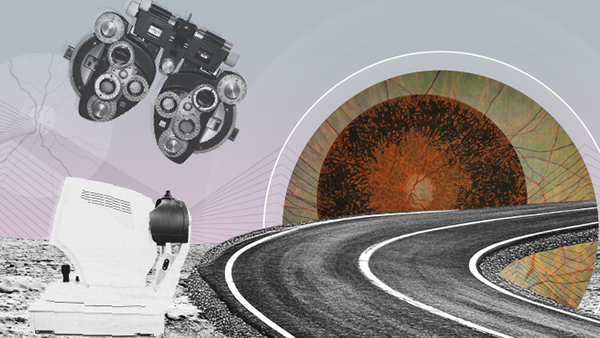You are viewing 1 of your 3 articles before login/registration is required
Oculomics and Schizophrenia
Is multimodal imaging of retinal features the future of neuropsychiatric disorder detection?
Though previous studies have applied multimodal imaging to determine associations between retinal features and schizophrenia, these reports have generally not factored in all confounding factors; notably, the presence of comorbidities, such as diabetes and hypertension, and lower socioeconomic status (and related effects; for example, alcohol misuse and smoking) have been shown to be more prevalent among individuals living with psychosis.
A new paper has acknowledged these well documented associations, while trying to better understand the connection between retinal changes observed in schizophrenic individuals (1). Using two independent deep learning based-models: VAMPIRE fractal dimension estimation module and AutoMorph for multimodal imaging of retinal features, the paper drew on data from the AlzEye Project – a database of over 353,157 patients at Moorfields Eye Hospital – to assess whether schizophrenia could be associated with larger cup-to-disc ratio (CDR), thinner macular ganglion cell-inner plexiform layer (mGC-IPL), and macular retinal nerve fiber layer (RNFL). The paper draws attention to how clinicians and researchers might integrate oculomics and deep learning tools to better assess the relationship between mGC-IPL thinning and other indices of accelerated aging in schizophrenia. We contacted Siegfried Wagner, an ophthalmologist at Moorfields Eye Hospital and one of the study’s lead authors, to discuss the potential impact of such research.
What initially attracted you to this line of research?
Recognition of the retina as an extension of the central nervous system has motivated much research into neurological disorders, but that focus on psychiatric disease remains relatively limited. Mental health disorders straddle a complex area defined by biological, social, and psychological nuance. Here, retinal imaging may reveal mechanistic insights into the biology of psychiatric disease, particularly on the role of neurodegeneration.
Given the confounding impact of comorbidities, how conclusive were the study findings?
I think the direct association between thinner inner retinal sublayers (GCIPL) and schizophrenia is quite convincing – it concurs with previous work, and is robust to adjustment for multiple confounders and subgroup analyses. I agree that the retinovascular differences are indeed attributable to the medical comorbidities – specifically diabetes and hypertension – although I would argue that these retinal vascular markers could still be useful in identifying those with schizophrenia who are at higher risk of developing medical comorbidities. Of course, these changes were associated with the disease already being there, but they also probably pre-date the onset.
What were the main limitations of your recent study?
As this study involves data from patients attending a National Health Service ophthalmic hospital, the findings relate to those with eye disease and may not reflect what is seen in all individuals with schizophrenia. Also, there are other possible confounders, such as antipsychotic use, which we could not control for. Some of our future work is designed to mitigate against these limitations.
Could you share details about your future work?
Future strands of work will include i) longitudinal analysis to see whether trajectories of oculomic markers have utility for defining risk of future cardiometabolic and neurological dysfunction in individuals with schizophrenia, and ii) eye–brain phenotyping studies to elucidate what the observed differences in retinal morphology may be reflecting in the brain.
How do you see AI and deep learning tools developing to better facilitate such multimodal research?
That’s a tough question! I think a major challenge will be accurate segmentation with quantification of confidence/measurement error. With huge datasets, we can apply some broad methods for quality control, but this is an imperfect solution for what is a major obstacle in retinal “big data” research. We need robust and reproducible methods to know when AI model outputs are inaccurate; for example, is it image quality or is it incidental pathology in the given scan?
What impact would your research have in an ideal world – with no limitations?
I would like to see retinal imaging become part of the standard of care for individuals with schizophrenia and other systemic disorders. Most modalities are non-invasive and increasingly available in community and hospital settings. They are also relatively cheap and require nominal expertise for acquisition.
What advice can you offer other researchers in this field?
Interdisciplinary collaboration is key. Dedicated to ophthalmology and vision science, most ophthalmologists have limited experience in pathophysiology outside of the eye. Diving into unfamiliar territory, like the neurobiology of psychosis, is rewarding – but you need collaborators willing to engage and share knowledge. Find people with enthusiasm (and patience!) to cultivate your understanding of their field – and people who have an openness to learn more about ophthalmic science from you.
This article first appeared in The Ophthalmologist
Reference
SK Wagner, “Association Between Retinal Features From Multimodal Imaging and Schizophrenia,” JAMA Psychiatry (2023). Available at: bit.ly/3G42w3j.
The New Optometrist Newsletter
Permission Statement
By opting-in, you agree to receive email communications from The New Optometrist. You will stay up-to-date with optometry content, news, events and sponsors information.
You can view our privacy policy here
Most Popular
Sign up to The New Optometrist Updates
Permission Statement
By opting-in, you agree to receive email communications from The New Optometrist. You will stay up-to-date with optometry content, news, events and sponsors information.
You can view our privacy policy here
Sign up to The New Optometrist Updates
Permission Statement
By opting-in, you agree to receive email communications from The New Optometrist. You will stay up-to-date with optometry content, news, events and sponsors information.
You can view our privacy policy here







